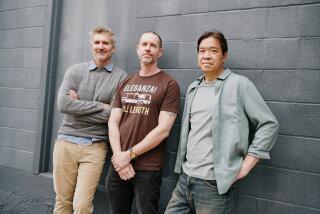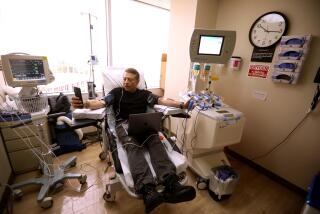You Look Marvelous : THE FUTURE OF THE BODY: Explorations Into the Further Evolution of Human Nature, <i> By Michael Murphy (Jeremy Tarcher: $30; 785 pp.)</i>
- Share via
Other visionaries, such as Sir Thomas More, have outlined plans for achieving perfection one soul at a time. Michael Murphy has a bigger idea. In “The Future of the Body” he proposes that mankind is on the brink of “a new kind of life on this planet,” a global Utopia in which we all may develop startling mental, physical and “paranormal” abilities.
The hypothesis of this book--that evolution is poised to produce a new society of super human beings--is so grand that it could be dismissed as fantasy. As the co-founder of Esalen, Murphy is a leader in the modern “human potential movement” and at times his book does reflect the self-improvement impulse gone berserk.
There is much of value in “The Future of the Body,” which should not be dismissed as New Age propaganda. Murphy has put a decade into composing his argument, and he has pulled together an impressive collection of fact and historical record to make his case. “The Future of the Body” presents a thorough compilation of the science, faith and folklore that inspire the New Age belief in the ultimate perfectibility of man. As such, it may be the ultimate New Age work, touching on all the elements of human potential--health, creativity, morality, and the paranormal--that concern the broader New Age movement. A combination spiritual text and almost scientific study, this book makes the strongest argument possible for the dawn of a shining era of personal and social development.
“The evidence assembled here suggests that we harbor a range of capacities that no single philosophy or psychology has fully embraced,” Murphy explains, “and that these can be developed by practicing certain virtues and disciplines and by building institutions to support them.”
Murphy presents an encyclopedic review of the evidence of both ancient miracles and modern research on the mind’s role in fighting disease and cultivating extraordinary physical abilities. Here we find accounts of mystics and shamans next to medical researchers’ reports on the special sensitivities of the deaf and the blind. Murphy describes in detail how placebos can relieve pain and how meditators can slow their heart rate and psychotherapy can improve overall health.
As he catalogues the ways certain people have apparently used their minds to heal themselves, Murphy proceeds to argue that we all might develop such powers and employ them at will. Like Buddhist monks or supremely-gifted athletes, we could all learn to overcome pain, move with extraordinary grace and even change the shape of our bodies. “Although these changes typically involve disability and suffering,” Murphy argues, “they dramatize transformative capacities that can, I believe, be cultivated to promote human growth.” The evidence is fascinating, even if his conclusion--that it adds up to the evolution of a superhu man--is far-fetched.
Besides presenting an argument for evolution of the New Age man, Murphy presents a fascinating report on the history of miracles and science’s enduring curiosity about the “metanormal.” Here the reader discovers that Freud thought he was connected, telepathically, with some of his patients and that the 19th Century physicist Sir William Barrett believed he had proven the existence of clairvoyance through experiment.
Although he intends to use the historic record to prove that such New Age staples as ESP and clairvoyance are real, the effect is quite the opposite. Murphy’s most interesting stories about paranormal phenomenon pre-date the 20th Century, and they have a dusty, muddle-headed quality. No skeptical reader would be swayed by his anecdotes about Mesmerism or mystics who claimed to levitate. And since Freud was wrong about many things, the fact that he once believed in telepathy is hardly convincing.
Worse are the passages where Murphy dismisses modern scientific debunking of the paranormal as close-minded bias. In fact, many of the most important studies of psychic phenomenon have been seriously flawed or even fraudulent. Science writer Martin Gardner and magician James Randi have made careers out of unmasking New Age hucksters and disproving the claims of more legitimate researchers who want so much for the paranormal to be true, that they craft their experiments to produce a positive result.
Murphy ignores these problems and instead attacks the modern science that Gardiner, Randi and others represent as biased and hidebound. He ‘cops out,’ arguing that science is simply not yet up to the task of recognizing realities. “This reversal of scientists’ frequent complaint about mystical truth and PSI phenomenon seems entirely legitimate to me,” writes Murphy. “Should an ancient body of testimony supported by religious figures and philosophers with radically different backgrounds since the beginnings of recorded time be denied because it causes difficulty for certain scientists?”
In fact, the answer to Murphy’s rhetorical question may be, “Yes.” The history of modern science can be seen as a brave attempt to overcome the biases of religion and the power of established authorities. The same clerics and philosophers who believed in the mystical realities that Murphy supports, also believed the world was flat, the sick were possessed by evil spirits and the Earth was the center of the universe. And the physicians of old, whom Murphy praises for their treatment of the spirits and emotions of their patients, did so because they could do little else. When given a choice between penicillin administered by a cold clinician and the kindly empathy of a faith healer, anyone with a strep throat would still be best advised to accept the penicillin.
As he embraces the magical beliefs of ancient peoples, Murphy reveals that despite his academic pose, “The Future of the Body” is more about spiritual faith than scientific proof. Indeed, the main problem with this book is that it insists on granting everything, from silly superstition to serious science, the same weight. Most attempts to cobble together empiricism and faith only cheapen both. Faith is belief in a truth that requires no evidence. Science calls for adherence to demonstrable truth, despite belief. As he struggles to combine the two, Murphy falls back on an argument heard throughout the New Age; those who disagree are somehow blind. People reject ideas such as ESP, or the power of the mind to move inanimate objects because they “lack acquaintance with the data,” he writes. If only we all understood, as he does, then we would believe.
For those who already believe, “The Future of the Body” will serve as the ultimate reference, the place to find all the best sources to support the conclusion that the New Age is at hand. Those who do not believe may appreciate the breadth of Murphy’s effort, but will likely discover that this book suffers the same basic problem that plagues the entire New Age movement; what is good and important in it is too often obscured by the bizarre. Ironically, a less ambitious writer might have proposed a more limited view of Utopia and produced a better book.
More to Read
Sign up for our Book Club newsletter
Get the latest news, events and more from the Los Angeles Times Book Club, and help us get L.A. reading and talking.
You may occasionally receive promotional content from the Los Angeles Times.







